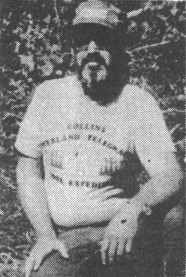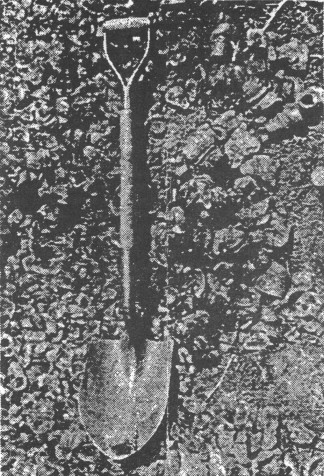Cumberland Collector Searches For Rare Insulators in Canadian Wild
Reprinted from "INSULATORS - Crown Jewels of the Wire", August 1983, page 36
Atlantic Farm Monthly August 28, 1982, Page 7
By Rosemary Schrier of Cumberland
A Cumberland
farmer's hobby recently took him into the northern wilderness area of British
Columbia, Canada, in search of Collins Telegraph insulators.
Collins Overland
Telegraph, sponsored by Western Union, had devised a plan to link America and
Europe with a telegraph line connecting onto the line that had earlier reached
San Francisco, Calif., from New York, N.Y., in 1861.

Cecil Boos
The line was to go north
through British Columbia, northwest through the Yukon and Russian America (now
Alaska), under the Bering Strait into Siberia and hook up with a line the
Russians were building.
The project was abandoned in 1866 after the successful
laying of the trans Atlantic ocean cable. More than $3 million had been invested
by Western Union on the project. They just walked away, leaving behind tools,
wagons, wire and insulators. The last supply station was approximately 60 miles
south of the Yukon-Alaska border.
Reached Area
Cecil Boos, who has been an
insulator collector since 1968, spent three weeks in search of the rare
insulators along with a friend, Ray Klingensmith of East Orwell, Ohio, also an
enthusiastic collector.
Ray had spent several months alone last summer in the
same area searching for the insulators, but did not have much luck at that time.
He had researched the Collins line for five years so knew the general vicinity
in which to look. They were planning to go earlier this year to avoid some of
the discomforts of the area. Ray drove his car up in March and Cecil was to
follow in April.
The day before Cecil was to leave by plane to go north, Ray
called and said to wait another month. It seems that the winter had been just as
harsh and late in British Columbia as the one Iowa had just gone through, and
there was still too much snow. They had received 20 feet of the cold white
"stuff".
During a normal spring you wouldn't be able to get most
farmers to leave at this crucial planting time, but this year has been far from
normal in south-west Iowa. With very few rainless days in May and nothing
planted, Cecil was getting frantic. He wanted to go so very much but the crops
weren't in. He lost 30 pounds and his wife, Sharon, told him he'd better go
before he lost any more weight worrying about it, so on May 24 he finally left.
His wife and son, Dan, would take care of the farm during his absence.
Stuck In
Snow
Cecil and Ray met again at Smithers, British Columbia, and after getting
supplies together, started out only to get stuck in about two feet of snow.
After digging themselves out and backtracking, they ran out of the snow about
six miles south. By the time they worked their way back the snow was melted.
Armed with old maps and manuscripts, they put on their back-packs loaded with
the necessary supplies. One thing they really depended upon was a compass.
Without it one could easily become lost in the wilderness they would cover. They
set up a camp and returned to it each evening.
A metal detector came in handy to
locate the wire which after 116 years was covered with growth of trees, soil and
moss. Sometimes they would pull up miles of wire containing no insulators. At
other times it was frustrating when the wire couldn't be located because Indians
had used it to build suspension bridges over gorges. The metal detector located
splice and tie wire and if they were lucky -- an insulator would be there too.
They found thousands of insulators, but most of them were broken. Some had been
melted by forest fires.
Some of the obstacles they had to overcome included
hordes of mosquitoes and black flies that would constantly harass them. The area
became filled with swamps after the snow melted and the pests came on strong.
Mosquito nets were put to use, but there wasn't much protection from the black
flies.
Rain Forest
They passed through rain forest areas where moss grew on
everything making the travel slow. Underfoot it was like walking on a sponge and
the underbrush grew quickly in the 80 degree temperatures. They knew it would
soon become impossible to penetrate the jungle like growth so had to make the
most of the time they had.
"Devils Clubs," a tall rubbery plant that
grows in the northern swampy areas, were really a nuisance, too! They are
covered with stickers and would bounce back and hit them, piercing their skin.
Grizzly bears roamed the area where they were doing their search for the
insulators. They weren't allowed to carry handguns, so they wore sleigh-bells on
their boots and blew whistles periodically and the bears stayed away from them.
The bears could be seen standing on their hind feet watching them from behind
the bushes. The men wrapped their food real well and enclosed it in plastic
bags, then hung it from high tree branches so as not to attract the bears.
Rare
Orchid
Cecil and Ray took time to appreciate the beauty of the north while they
were there. Cecil has some beautiful colored pictures that he took of rare
Calypso orchids that grow in the swampy region. He said wild roses grow as tall
as a man and the fir trees were gigantic. Some of the country they passed
through had rugged mountains, noisy mountain rivers and peaceful meadows. Cecil
wore out a new pair of boots on the trail.
The area where the two men were
insulator hunting is so remote that only one party is known to have been there
in the past year to hunt grizzly bears.
In the populated area they found the
natives to be quite friendly. A long-time guide gave them much information that
they really appreciated. They found out later that for years this same guide had
been guiding bear hunters on a trail that passed within 20 feet of the spot
where Cecil and Ray found the remains of the last supply station. Ray had also
passed over it last year without knowing it lay under his feet.

A spade and some Collins insulators, both broken and good ones.
All the insulators had to be dug out of the ground after 116 years had
passed since they were abandoned by the telegraph line.
Cecil and Ray
did not come home empty handed. They divided the good insulators they found and
also brought back other mementos of their trip: splice and tie wires, melted
insulators, square nails and Cecil also has two rare blue Russian trading beads
that the Russians traded to the Indians.
Cecil has "hundreds" of
insulators in his collection and the Collins insulators are among his favorite
ones.
He is a member of the National Insulator Association, and the Missouri
Valley Insulator Club. He attended the national show in Cedar Rapids July 16-18
and displayed some insulators. He received a first-place trophy for the best
single color display and won the best of show honor.
Of his trip into the wilds
of the north Cecil said, "It was a once in a lifetime experience and I'm
glad I went even though most of the insulators we found were broken."
The
preceding article is reprinted with permission, and Cecil Boos has dedicated
it to Ray Klingensmith, for without his hard work none of this would have been
possible.
| 